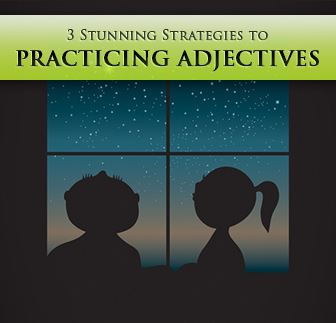The Biggest and Baddest of Them All: 5 Fun Activities for Practicing English Adjectives


Try these three stunning strategies to practice adjectives and adapt each one for various levels and needs.

You cannot go wrong utilizing pictures to practice using adjectives. There are so many great activities that you can generate as long as you have a stock of photographs. Choose glossy pictures of people, outdoor scenes, homes, famous people, or anything else that you find interesting. Cut them out of magazines and glue them to construction paper and laminate for even longer use. You can begin with thirty to forty pictures and continue adding to them when you have the time. There are endless possibilities for ways to use pictures. You can simply have students describe a scene or person they see on a picture and give them points for using as many adjectives as possible. You can vary difficulty by choosing challenging pictures, focusing on -ed/-ing adjectives, or by applying more objectives. Another popular use for pictures that is often a perfect introduction for lower-level learners is illustrating a picture. Put the students into pairs, and give one student a picture of a person or a room. The student with the picture must describe it to his or her partner so that the partner can draw an imitation of what they hear. You could supply colored pencils so they can add color, or practice prepositions of place as well as characteristics and basic descriptions. Students will enjoy comparing the real photograph with their own illustration. This can be done with advanced levels too, and you could even have the illustrator be blindfolded for extra challenge.
Another use for pictures is creating a picture puzzle by covering a photograph with post it notes. In front of the group remove one sticky note at a time and have students describe what they see. They can try to guess what they think the picture is or what might be happening. As you remove more slips of paper, students begin to see things emerging differently. It's also fun to add in pictures of artwork or use obscured pictures to keep students guessing.
Using guessing games like twenty questions is a simple, no-fuss way to practice adjectives. These exercises will keep your students engaged, and you can find many ways to turn them on their side so you are not just playing the same game over and over again. Discover all the different ways that you can play guessing games and utilize adjectives that are applicable for varied levels. One way to practice higher level adjectives is to assign students particularly advanced or difficult adjectives. Examples could be: ridiculous, humbling, educating, etc. Students take turns getting the class to guess what word they have by describing it or giving example scenarios. The audience can then ask yes or no questions to gain more information about the word. To make it even more challenging, you could supply a list of words that students cannot use when describing their adjective. Students of all ages will enjoy this twist on twenty questions. Another guessing game that is superb for characteristics or emotions is to have students play famous person twenty questions. The twist here is that they can only use characteristics in guessing. For example, Is the person humble/funny/adventurous? You could also only allow them to ask questions with ed/ing adjectives. Making twenty question competitive by splitting classes into teams can also provide positive results. Even a simple game like I spy can be ratcheted up a notch by employing a few guidelines or team dynamics. Tell students they can guess everything except colors, or devise questions using comparisons to other objects. For example: Is it bigger than a coffee mug? Is it smaller than a bicycle? Test out different ways to make twenty questions an intense guessing game that will challenge as well as delight your students.
Activities focused on opinions use a great deal of descriptive language and can be adapted for just about any level. Create a short or extensive poll using statements. Students only have the option of agreeing or disagreeing with each statement, and should work fairly quickly to complete the handout. Some example statements with different themes are:
| A/D | Politicians are dishonest and self-serving. |
| A/D | Politicians want to be respected and powerful. |
| A/D | A hero wants to be rewarded. |
| A/D | A hero is selfless and caring. |
| A/D | Vacations should be educational and meaningful. |
| A/D | Vacations should be relaxing, and not too busy. |
| A/D | Vacations are overrated and stressful. |
For each poll you create, each topic should have at least five to seven statements so you have enough examples for students to base their overall opinion on. Review any difficult vocabulary beforehand, hand out your poll, and have each student complete the task individually. Once completed, discussion can begin. The goal of the exercise is to get students talking about their opinions in a non-confrontational way using descriptive language. Supply them with the requisite language to defend their choices and also to allow them to create their own definitions. A good wrap-up to this activity is for each topic discussed, students write a short opinion. For example, I think a hero is brave, but doesn't have to be strong. A hero is a person who is helpful, but not looking for praise or money.
Employ these three strategies to keep students guessing, talking and constantly describing.